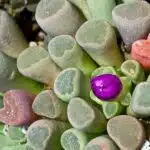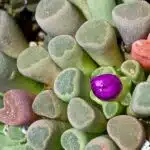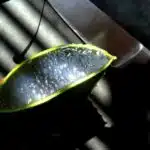Succulents have gained immense popularity in recent years due to their striking appearance and low maintenance needs. Their ability to propagate from leaves makes them an ideal plant for those looking to expand their collection or share cuttings with friends and family. While propagating succulents from leaves may seem daunting, it can be a simple and rewarding process with the right knowledge and technique.
As a succulent propagation expert, I have seen many people struggle with this process, often resulting in unsuccessful attempts. However, with a few key steps, anyone can successfully propagate their own succulent leaves into thriving plants. Not only is propagating succulents from leaves a great way to expand your collection, but it also allows you to share the joy of these unique plants with others. In this article, I will guide you through the process of propagating succulents from leaves, providing tips and tricks along the way to ensure your success in serving yourself and others within the succulent community.
Understanding Succulent Propagation
Succulent propagation techniques have become increasingly popular in recent years as more people become interested in gardening and plant care. Propagating succulents from leaves is a simple and affordable way to grow new plants, but it requires patience and attention to detail. There are several common mistakes that beginners make when attempting to propagate succulents, which can result in failed attempts.
One of the most important things to remember when propagating succulents from leaves is to choose healthy leaves from mature plants. The leaves should be plump and firm, with no signs of damage or disease. It is also important to use a clean, sharp knife or scissors when removing the leaves from the plant, as this will help prevent infection.
Another common mistake that beginners make is not allowing the cut ends of the leaves to dry out before planting them. Succulent leaves need time to callus over before they can be planted in soil or water. This process can take several days, depending on the humidity and temperature of your environment. Once the cut ends have callused over, you can then plant them in well-draining soil or water according to your desired propagation method.
When choosing the right leaves for propagating succulents, it is important to be selective and patient. By following these simple steps and avoiding common mistakes, you can successfully propagate your own succulent garden.
Choosing The Right Leaves
When it comes to propagating succulents from leaves, choosing the right ones is crucial. It is like selecting the perfect ingredient for a recipe that will determine the outcome of your dish. The same goes for leaf selection in succulent propagation. The ideal leaves should be plump and healthy-looking, with no signs of damage or disease.
To ensure a successful propagation process, you must pick leaves that are actively growing on the plant. Do not select fallen leaves or those that have been cut off from the plant for an extended period as they may not produce roots or new growth. Once you have chosen your leaves, handle them with care, and avoid damaging their bases because this can affect their ability to root.
Before starting the propagation process, prepare your selected leaves by gently removing them from the parent plant using a sharp and clean pair of scissors or pruning shears. Be sure to leave at least 1 inch of stem attached to each leaf to provide enough surface area for rooting hormones to develop. With proper leaf selection and preparation, you are one step closer to successfully propagating your succulents and expanding your collection!
Preparing Your Materials
Gathering Materials is an essential step in propagating succulents from leaves. The materials needed for this process are easily accessible and straightforward. It would be best if you had a healthy plant, sharp scissors/knife, a pot with appropriate soil mixture, and water.
When choosing a healthy plant to propagate from, look for one that has plump leaves and no signs of damage or dehydration. This ensures that the new growth will also be healthy. The pot used should have drainage holes at the bottom to allow excess water to escape and prevent root rot. The soil mixture should be well-draining with sand or perlite mixed in.
Tools Needed for propagating succulents from leaves include a sharp pair of scissors or knife to ensure clean cuts without damaging the parent plant’s stem. It is essential to use sanitized tools to avoid spreading diseases between plants. Sanitizing can be done by washing with soap and water or wiping with rubbing alcohol before use.
In summary, Gathering Materials is crucial when propagating succulents from leaves, as it determines the success of the process. Tools needed include sanitized sharp scissors/knife, well-draining soil mixture, appropriate pot size with drainage holes at the bottom, and water. When selecting a healthy plant for propagation purposes, look for one with plump leaves and no signs of damage or dehydration.
Removing The Leaves
Leaf selection is an essential aspect of succulent propagation. Choosing the right leaves can make a significant difference in the success rate of propagating new plants. When selecting leaves, it is crucial to pick healthy and mature leaves that are free from damage or disease. Look for leaves that are plump, firm, and have good color.
Once you have selected the best leaves for propagation, the next step is leaf preparation. It involves gently removing the leaves from the mother plant by twisting them gently at their base until they come off cleanly. Avoid using scissors or pulling as this may damage the leaf or even separate it from its stem. After removing the leaves, allow them to dry out for a day or two before proceeding to the next step.
Proper leaf preparation is crucial for successful propagation. Drying out allows any cut areas to callus over, which helps prevent infection and promotes rooting when planted in soil or water. It’s important to note that skipping this step can lead to rotting of the leaf when planted, resulting in failure in propagating new plants. Therefore, it’s vital to be patient during this stage before moving on to allowing the leaves to callus further.
Allowing The Leaves To Callus
Once you have removed the leaves from your succulent plant, it is important to allow them to callus over before planting them. This process involves leaving the cut end of the leaf exposed to air for a period of time, which allows it to dry out and form a protective layer. This layer will help to prevent rot and other issues that can occur during propagation.
To encourage callusing, place the leaves in a warm, dry location with good airflow. Avoid humid or damp areas, as this can interfere with the callusing process. You may also want to consider placing the leaves on top of a paper towel or other absorbent material to help wick away any excess moisture.
During this time, it is important to continue with your regular succulent maintenance routine. Water sparingly and avoid getting water on the leaves themselves, as this can also lead to rot. By taking these precautions and allowing your leaves to callus properly, you will be able to successfully propagate your succulents and enjoy a new generation of plants in no time.
- Picture a sunny windowsill where you can leave your succulent leaves to callus.
- Imagine gently patting down each leaf onto an absorbent paper towel.
- See yourself carefully watering nearby mature plants while avoiding any contact with the drying-out leaves.
- Envision a beautiful collection of propagated succulents thriving in their pots thanks to proper care during every step of the process.
As you prepare for the next step in propagating your succulent plants, it is important to choose the right potting mix in order to ensure their continued health and growth.
Choosing The Right Potting Mix
- The pH balance of the potting mix is an important factor to consider when propagating succulents from leaves, as it can affect the ability of the soil to absorb certain nutrients.
- Proper drainage is also essential for propagating succulents from leaves, as it helps ensure the roots of the new plant are not waterlogged.
- The choice of potting mix should provide the ideal combination of pH balance, soil drainage, and nutrients for the best results when propagating succulents from leaves.
- Therefore, selecting the right potting mix for succulent propagation is essential for successful propagation from leaves.
Ph Balance
When propagating succulents, it is essential to choose the right potting mix that will provide them with the necessary nutrients and drainage. However, one crucial factor that often gets overlooked is the pH balance of the soil. The pH level of the soil can have a significant impact on the growth and health of your succulent. Therefore, it is essential to use pH strips to test the soil’s acidity or alkalinity before planting your succulent.
Balancing soil pH is crucial because it helps in nutrient uptake by plants. If the soil’s pH level is too high or too low, it can affect how your succulent absorbs water and nutrients from the soil. A pH level that is too acidic can lead to stunted growth and yellowing leaves, while a pH level that is too alkaline can result in nutrient deficiencies and poor root development. Therefore, it is crucial to balance your potting mix’s pH level by adding amendments such as dolomite lime or sulfur.
Using pH strips to test your potting mix for proper acidity or alkalinity levels will ensure that your succulents grow healthy and strong. By balancing your soil’s pH, you’ll be providing an optimal growing environment for your plants. Always make sure to follow instructions when using any additives or amendments in your potting mix, as overuse can lead to imbalanced soil conditions that may harm your plants instead of helping them thrive. Remember, balanced soil pH equals happy succulents!
Soil Drainage
Choosing the right potting mix is crucial when propagating succulents. It provides your plants with the necessary nutrients and a growing environment that promotes healthy growth. However, it’s not just about the nutrients that you put into the soil; proper drainage is also essential for your succulent’s well-being. Having improved drainage in your potting mix allows excess water to flow out of the container, preventing soil saturation and root rot.
To ensure proper soil drainage, you need to choose a potting mix that has a good balance of organic matter and inorganic materials. Organic matter, such as peat moss or coconut coir, helps retain moisture while inorganic materials like perlite or pumice provide space for airflow and prevent compaction. A good rule of thumb is to use a 50/50 blend of organic and inorganic materials for succulent propagation.
When using a potting mix with improved drainage, make sure to water your succulent thoroughly but sparingly. Succulents are adapted to survive in arid environments where water is scarce. Overwatering can lead to root rot and other problems. Allow the top inch of soil to dry out before watering your plant again. Remember that proper soil mix and improved drainage work hand-in-hand in providing an optimal growing environment for your succulents.
Planting The Leaves
Like a painter carefully selecting their brush strokes, planting techniques play a vital role in propagating succulents from leaves. To ensure the success of your propagation journey, it is crucial to choose the right orientation for each leaf. The orientation of the leaf plays a significant role in its capacity to root and grow into a healthy plant.
When planting the leaves, it is essential to keep the cuttings dry for a few days until they form calluses. Once calluses have formed, gently place the leaves on top of well-draining soil and cover them with a thin layer of sand or gravel. It is important to select an area with bright sunlight, as this will encourage growth and prevent rotting.
Leaf orientation also plays an important role in successful propagation. When planting your leaves, ensure that you position them in such a way that the end which was closest to the stem is inserted into the soil. This end contains meristematic tissue that can quickly produce roots when exposed to soil moisture. With proper planting techniques and careful attention to leaf orientation, you’ll be well on your way to propagating beautiful and healthy succulents.
As we’ve seen, planting techniques and leaf orientation are critical factors in successful succulent propagation. However, these efforts must be complemented by appropriate watering techniques to encourage growth and development properly. In the next section, we’ll explore some best practices for watering your newly propagated succulent leaves.
Watering Techniques
After planting the leaves, it is important to ensure they have enough water to grow into new plants. However, watering frequency and soil moisture are crucial factors that need to be taken into consideration. Over-watering can lead to rotting of the leaves, while under-watering can cause them to dry out and die.
Watering frequency will depend on various factors such as the size of the pot, type of soil used, and environmental conditions. Generally speaking, it is recommended to water succulent leaves once a week during the growing season (spring and summer) and every two weeks during the dormant season (fall and winter). It is important not to let the soil dry out completely between watering sessions as this can damage the roots.
Soil moisture is equally important when propagating succulents from leaves. The soil should be well-draining and not retain too much moisture. An ideal soil mix for propagating succulents would consist of equal parts potting mix, perlite, and coarse sand. This ensures that excess moisture drains away from the roots quickly, preventing any chance of root rot. By providing adequate water and maintaining proper soil moisture levels, you can successfully propagate succulents from leaves in no time! In order for your propagated succulents to thrive, however, they will need adequate lighting – which we will discuss in our next section.
Providing Adequate Lighting
One of the most crucial factors in successfully propagating succulents from leaves is providing adequate lighting. Without sufficient light, the leaves will not be able to photosynthesize and produce roots and new growth. In fact, light is so important that it can make or break your propagation efforts.
Using grow lights can be an excellent way to ensure your succulent leaves receive optimal lighting conditions for successful propagation. Grow lights provide a consistent source of artificial light that mimics natural sunlight, making them an ideal option for those who don’t have access to enough natural light sources. However, if you do have access to natural light sources such as a sunny windowsill or a greenhouse, you may not need to invest in grow lights.
Regardless of whether you’re using natural or artificial light sources, optimizing the duration and intensity of light exposure is key to successful propagation. Succulent leaves require bright but indirect sunlight for several hours each day. Keeping your plants too close to direct sunlight can scorch their leaves, while keeping them in too much shade can result in stunted growth or even death. By following these succulent lighting tips and tricks, you’ll be well on your way to growing healthy new plants in no time.
With proper lighting taken care of through either grow lights or natural sources, it’s time to move onto monitoring growth progress.
Monitoring Growth Progress
Timing is an important factor when propagating succulents, as the right window of opportunity can ensure successful results. Watering should be done carefully, as over-watering can lead to root rot. Fertilization should be done in moderation to ensure that the succulent is not over-fertilized. Light requirements should be met by providing the succulent with the right amount of sun exposure and shade.
Timing
Succulent propagation is a rewarding and exciting process, but it requires patience and attention to detail. One of the critical aspects of monitoring growth progress is timing. To achieve successful propagation, one must understand the early stages of growth and provide optimal conditions for the plant.
In the early stages of propagation, it is essential to monitor the leaves’ progress regularly. The first sign of growth will be small roots emerging from the leaf’s base. At this point, it’s crucial to ensure that the plant has adequate access to water and nutrients. Overwatering can lead to rotting, while under-watering can cause stunted growth or even death. It’s essential to strike a balance by keeping the soil moist but not soaked.
Optimal conditions are also necessary for healthy growth. Succulents thrive in bright light with temperatures ranging between 60°F-80°F (15°C-26°C). During propagation, it is best to place them in a warm spot with indirect sunlight. A lack of sunlight may slow down growth or lead to leggy plants with weak stems.
In conclusion, monitoring growth progress during succulent propagation requires attention to timing and optimal conditions. By being vigilant during the early stages of growth and providing adequate access to water and nutrients, one can achieve successful propagation. Additionally, placing plants in a warm spot with indirect sunlight will encourage healthy growth and prevent legginess. With these tips in mind, you’ll be on your way towards propagating beautiful succulent plants!
Watering
As a succulent propagation expert, monitoring growth progress is crucial to ensure successful plant propagation. One of the critical aspects that require close attention is watering. Proper drainage is essential when it comes to watering succulents. Overwatering can cause the soil to become waterlogged, leading to root rot and ultimately killing the plant. On the other hand, under-watering can cause the leaves to wither and fall off.
To avoid overwatering, it’s crucial to provide proper drainage by using fast-draining soil and pots with drainage holes. Watering frequency also plays a crucial role in succulent propagation. During the early stages of growth, it’s essential not to water too frequently as this can lead to rotting or stunted growth. It’s best to let the soil dry out between watering sessions.
By being vigilant about watering frequency and providing proper drainage during succulent propagation, one can achieve healthy plant growth. Monitoring the soil moisture level regularly is key in determining when it’s time to water your plants. With these tips in mind, you’ll be able to propagate beautiful and healthy succulent plants for yourself or those you wish to serve by sharing your propagated plants!
Identifying Signs Of Success
After monitoring the growth progress of your propagated succulents, you may start to notice small changes and milestones. Measuring growth is an essential part of this process, as it allows you to keep track of how well your succulent is doing and determine whether any adjustments need to be made. One way to measure growth is by using a ruler or tape measure to record the height and width of your plant. Another method is by taking photos at regular intervals and comparing them over time.
Celebrating milestones can also be a fun way to motivate yourself throughout the propagation process. These milestones could include the appearance of roots, the emergence of new leaves or shoots, or even the first signs of color on your plant. Taking note of these moments and sharing them with others who are interested in succulent propagation can help build a sense of community and excitement around this hobby.
Once your propagated succulents have reached a certain size or stage, it will be time to consider transplanting new growth into its own container. This process requires careful handling and attention to detail, as it can be stressful for young plants. In the next section, we will discuss some tips for successfully transplanting new growth and ensuring that your propagated succulents continue to thrive in their new home.
Transplanting New Growth
Once new growth has appeared on your propagated succulent leaves, it is time to transplant them into their own containers. Transplanting will provide the new growth with more space and nutrients to continue growing. Here are some tips on how to successfully transplant your new succulent growth.
First, choose a container that is slightly larger than the size of the new growth. Succulents prefer well-draining soil, so make sure to use a potting mix specifically designed for cacti and succulents. Gently remove the new growth from its original container and carefully loosen any roots that have formed. Place the new growth in the center of the new container and gently fill with soil around it.
Secondly, water your newly transplanted succulent sparingly at first, allowing the soil to dry out completely between watering sessions. Once you notice that the plant has started growing again, you can begin watering it more frequently.
Finally, monitor your newly transplanted succulent for any signs of stress or disease. Common issues include root rot or pests such as mealybugs or spider mites. Catching these problems early can prevent further damage to your plant and allow it to thrive in its new home.
To ensure healthy propagation of your succulent leaves, here are some important techniques:
- Keep the leaves in a bright area without direct sunlight
- Mist spray regularly
- Do not overwater
- Ensure proper drainage by using well-draining soil
- Patience is key – do not disturb or move leaves until they show signs of growth
In order to troubleshoot common problems with newly propagated succulents, it’s important to understand their needs and how they may be affected by environmental factors. Let’s dive deeper into common issues that may arise when propagating succulents and how to address them effectively.
Troubleshooting Common Problems
After transplanting new growth, the next step in propagating succulents from leaves is to revive wilted leaves. It’s not uncommon for some of the leaves to become dehydrated or wilted during the process. To remedy this, simply mist the leaves with a spray bottle and place them in a shaded area for a few days until they regain their turgidity. In addition to misting, make sure to keep the soil moist but not waterlogged.
Preventing pests is also crucial during the propagation process. Mealybugs and spider mites are common pests that can damage or even kill young succulent plants. To avoid infestation, regularly inspect your plants for signs of pests and take action immediately if any are found. This can include physically removing visible bugs with tweezers or spraying the plant with insecticidal soap.
By following these steps, you’ll be well on your way to successfully propagating succulents from leaves. Don’t forget to share your success with others! A great way to do so is by starting a succulent swap with friends or joining an online community of succulent enthusiasts. Sharing your experiences and knowledge can help inspire others to try propagating succulents themselves and continue the cycle of growth and propagation.
Sharing Your Success With Others
- Encouraging others to share their successes can help foster a sense of community and camaraderie.
- Establishing a network of individuals who have achieved success can help motivate and inspire others to reach their goals.
- Celebrating accomplishments and milestones should be part of the sharing of success, as this helps to validate the hard work and dedication that went into achieving success.
- Sharing success stories and providing advice regarding how to achieve success can be beneficial to those who are just starting out.
- Creating a platform for individuals to share and exchange success stories, tips, and resources can help create an environment of support and collaboration.
- Understanding the fundamentals of propagation and how to propagate succulents from leaves is a fundamental skill for those wishing to share their success with others.
Encouragement
As a succulent propagation expert, I have seen many people discouraged when their efforts to propagate succulents from leaves do not yield the expected results. However, it is important to remember that success stories often arise from failures. Motivational quotes such as “failure is simply the opportunity to begin again, this time more intelligently” by Henry Ford can provide encouragement in these situations.
Sharing your success with others can also be a source of encouragement. When you successfully propagate succulents from leaves, share your knowledge and experience with others who are just starting out. Knowing that your success has helped someone else can be incredibly rewarding and motivating.
In conclusion, remember that setbacks are a part of the learning process. Do not let them discourage you. Instead, use them as an opportunity to learn and grow. And when you do succeed, share your story with others so that they too may find encouragement in their own journey towards propagating succulents from leaves.
Networking
Sharing your success with others is an important aspect of propagating succulents from leaves. Not only does it provide a sense of fulfillment, but it also allows for the opportunity to network with like-minded individuals who are passionate about succulent propagation. Collaborative projects and industry events are two ways in which networking can be achieved.
Collaborative projects provide a platform for succulent enthusiasts to come together and share their knowledge and experience. These projects can range from creating a community garden to starting a blog or social media page dedicated to succulent propagation. By working together, individuals can learn new techniques, troubleshoot problems, and gain inspiration from each other’s successes.
Attending industry events is another way to network with fellow succulent propagators. These events may include workshops, conferences, or trade shows where professionals in the field gather to showcase their work and exchange ideas. This is an excellent opportunity to learn about new products, techniques, and trends in succulent propagation while connecting with others who share the same passion.
In conclusion, sharing your success with others in the world of succulent propagation provides more than just personal satisfaction; it opens up opportunities for collaboration and networking within the community. Whether through collaborative projects or industry events, building relationships with fellow propagators can lead to increased knowledge, inspiration, and growth within this exciting field.
Celebrating Achievements
As a succulent propagation expert, it is important to not only share our success with others but also to celebrate our achievements. Celebratory rituals can bring a sense of accomplishment and pride, motivating us to continue learning and growing in this field. It can also serve as a reminder of the hard work that goes into propagating succulents from leaves.
Sharing our success with friends is another way to celebrate our achievements in the world of succulent propagation. Friends who share the same passion will understand the effort and dedication required to propagate healthy succulents from leaves. Sharing pictures or hosting a gathering to showcase our successes can be a fun and rewarding way to celebrate together.
In addition, celebrating our achievements can be an opportunity for self-reflection and goal setting. It allows us to assess what we have accomplished so far and plan for future growth. By acknowledging our successes, we can gain confidence in ourselves and inspire others who are just starting on their own propagation journey.
Conclusion: Enjoying Your Thriving Succulents
With the right care and attention, your succulent leaves will soon grow into thriving plants. As you continue to watch them grow, it can be a great idea to celebrate milestones along the way. This can include when they first sprout roots or when they produce their first set of leaves.
To help your succulents thrive, it’s essential to stay on top of their care needs. One important tip is to ensure that they receive enough sunlight, as this will ensure that they grow strong and healthy. Additionally, be sure to water them regularly but avoid overwatering which can lead to root rot.
As a succulent propagation expert, I encourage you to share your tips and tricks with others who may be interested in growing their own plants. By sharing what you have learned along the way, you can help others achieve success in propagating their own succulents. Whether it’s joining a local gardening group or simply sharing photos of your progress on social media, there are many ways to connect with others who share your passion for growing these beautiful plants.
- Consider creating a scrapbook or photo album to document the growth of your succulents over time.
- Experiment with different types of soil mixes and fertilizers to see what works best for your plants.
- Try propagating new varieties of succulents as you become more experienced in caring for them.
Conclusion
Succulent propagation is a fascinating process that brings about new life from the very leaves of these stunning plants. To embark on this journey, one must first understand the basics of succulent propagation and choose the right leaves for the job. With proper preparation and care, one can successfully remove and callus succulent leaves before transplanting new growth into fresh soil.
As with any endeavor, there may be challenges along the way. However, with patience and attention to detail, common problems such as rot or lack of rooting can be overcome. Once you have mastered the art of propagating succulents, you can share your success with others and watch as your thriving plants bring joy and beauty to your surroundings.
In conclusion, succulent propagation is a rewarding experience that allows us to witness nature’s incredible ability to regenerate and grow. By following these steps, you too can become an expert in this artful practice. So go ahead and plant those beautiful leaves – sit back and enjoy as they flourish into vibrant new succulents!
Image Credits
- “Succulent Blooms 2” by cobalt123 (featured)





























